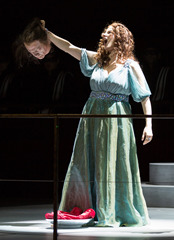| Opera Reviews | 13 May 2024 |
A perfect fit for the Philadelphia Orchestraby Steve Cohen |
|
| R. Strauss: Salome Opera Philadelphia/Philadelphia Orchestra May 2014 |
|
|
Yannick Nézet-Séguin has conducted several Strauss pieces this season to commemorate the composer’s 150th birthday. In cooperation with Opera Philadelphia, YNS this week led a staged performance of Strauss’ Salome. The choice is practical, because Salome runs less than two hours and it does not require as large a cast as some other Strauss operas such as Elektra, Rosenkavalier or Die Frau ohne Schatten. Nézet-Séguin told me this week that Salome is among his “top five opera masterpieces.” When pressed, he put it in the select company of Mozart’s Nozze di Figaro and Verdi’s La Traviata. The story has a primal appeal. Even if you don’t care about Biblical history, most people can relate to the plight of a spurned lover who feels “If he/she ever really saw me, he/she would have loved me.” The score is overwhelmingly rich and demanding, calling for 107 musicians. It also requires singer-actors with power, range and communicative skill. All in all, this turned out to be one of the most satisfying Salomes I’ve ever seen. (Karl Böhm conducting it, with Birgit Nilsson and Karl Liebl at the Met in 1965 is my standard for all comparisons; I’m too young to have seen the illustrious Lyuba Welitsch with Fritz Reiner.) Because the stage was so packed with instrumentalists, there was no way the cast could share that space. Therefore a special playing area had to be constructed above the orchestra—an extension of the balcony behind the stage which normally houses choruses that perform with the orchestra. In normal productions, Salome peers down into a cistern where the unseen Jochanaan is imprisoned. In this conception, he’s underground compared to the other characters, on the same level with the orchestra, behind the percussionists. Uniquely, we’re able to see him throughout the opera, and hear him without a subterranean echo. That was beneficial, because Alan Held was a sensational Jochanaan. His dark baritone, his enunciation, his muscularity and his acting were perfection. John Mac Master as King Herod also was superb; his voice projected strongly throughout the part’s wide range, with careful shading and coloring of the words, and he acted vividly. Camilla Nylund in the title role was a bit of a puzzlement. For the first two-thirds of the evening we admired her gleaming high notes but her volume faded away when she descended to the middle of her range. Strauss heroines need to have a strong middle-voice; her deficiency there was crippling. After her Dance of the Seven Veils, and after she tells Herod she wants the head of Jochanaan on a silver platter, she added a darker color to her tonal palette, probably as her way of showing determination. On the third and fourth repetitions of “Give me the head of Jochanaan” she added chest voice and louder volume and from there til the end of the opera she was mesmerizing. Nylund’s costume was a hindrance. She appeared with an unnecessary crown and in a gown that looked too mature for a teenager and too hot for anyone in Judea to wear. Otherwise, the direction by Kevin Newbury was apt. Seven globes hung above the stage, representing the moon that’s described so differently by various characters. (Oscar Wilde’s play and the opera’s libretto are notable for colorful similes: the moon is like a chaste virgin, the moon is like a silver flower, the moon is like a dead woman.) A telescope was downstage to call attention to the moon and the night sky and the approaching storm mentioned in the text. It also helped show that we were outside on a terrace. The telescope also reminded us that the love struck page, Narraboth, and the lascivious King Herod were constantly keeping their eyes on Salome. The dance was symbolic, with a decorative veil but no uncovering of bare skin. Nylund’s moves were not erotically tempting as a come-on to Herod, but were sensuous, as a reflection of her feeling about Jochanaan. The orchestra shimmered like a raven flapping its wings, and at other times growled like a caged beast. Its lower tones were especially memorable. These disturbing elements contrasted nicely with lyrical, beautiful melodies, bringing us to the point where we feel sympathy for Salome. Yannick says a performance is successful when the concluding chords wake us from a nightmare and we feel embarrassed and ashamed that we actually cared for Salome. Because the opera is so demanding, it could not be performed on consecutive days. This Salome, thus, had only two performances in Philadelphia and none in New York.
|
|
| Text ©
Steve Cohen Photo © Dominic Mercier |

 If ever an orchestra was made for the works of a specific composer, this is it. When Richard Strauss toured America in 1921 he conducted his orchestral works with the Philadelphia Orchestra. Many later performances of Strauss took place resplendently in Philadelphia, especially those led by music directors Stokowski, Ormandy and Sawallisch.
If ever an orchestra was made for the works of a specific composer, this is it. When Richard Strauss toured America in 1921 he conducted his orchestral works with the Philadelphia Orchestra. Many later performances of Strauss took place resplendently in Philadelphia, especially those led by music directors Stokowski, Ormandy and Sawallisch.






